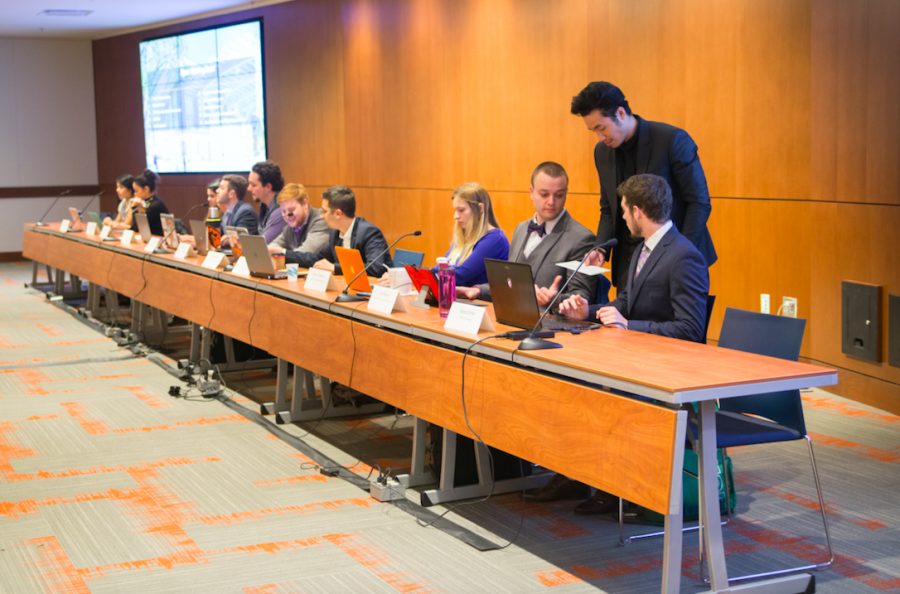Student Fee Committee makes budget recommendations for 10 fee-funded units
November 28, 2017
All budgets pass unanimously, excluding abstentions due to conflicts of interest.
Monday night, the Oregon State University Student Fee Committee discussed budget levels, heard public comments and unanimously made their recommendations for next year’s student fee levels.
All fee levels were approved by the entire body, with the liaisons from each unit abstaining from their organization’s vote due to conflicts of interest. With the recommendations finalized, the next step is a joint session of the ASOSU Congress scheduled for Jan. 24. Once budgets are voted on by both chambers of Congress, they will be sent to ASOSU President Simon Brundage for his signature or rejection. Then, OSU President Ed Ray and the OSU Board of Trustees have the authority to approve or reject the students’ proposed budgets, before the fee level is sent to the Oregon state legislature for final approval.
While students will likely pay a higher overall fee than last year, many of the units did not ask for an increase in funding to provide more services, according to SFC Chair Peter Schwartz. These increases in cost, known as current service level increases, cover expenses that units must pay outside of their control, such as utilities or higher wages. A number of units were able to internally restructure costs, so these additional expenditures will not be passed along to students.
The first budget discussed was the Family Resource Center, which provides students access to childcare. The SFC recommended a fee level of $9.92 for fall, winter and spring of next year and $4.07 for the following summer.
The FRC was followed by the Memorial Union organization, which has seen aspects of its budget moved to other units, such as Diversity and Cultural Engagement paying them for their custodial work, where in the past, this funding went directly to the MU. The MU recommendation was made at $55.15 for the academic year and $47.43 in the summer.
Next, the Student Leadership and Involvement’s budget was discussed. Components of the budget were adjusted from last year, such as the reallocation of funding for the Night Owl bus to ASOSU and the cost of Creative Services from the MU’s budget to theirs, however, the overall fee level was unaffected, according to Schwartz. The recommendation for Student Leadership and Involvement’s fee level next year is $36.16 during the academic year and $22.63 in the summer.
The OSU Athletics Department, which receives student fees to pay for student tickets to athletic events, requested a flat fee from last year at $38.86 during the academic year and no fee during the summer. This unit was the only fee level that drew contention during the session. A number of ASOSU senators and representatives questioned the importance of this funding compared to other units. After much discussion, the SFC voted in favor of the $38.86 flat fee from the previous year.
The Performing Arts Department requested and received a total fee level of $6.67 for the academic year, which includes a $0.88 decision package.
The Human Services Resource Center requested a $1.35 decision package beyond their academic year base budget of $7.78 to double their full-time staff members to two. Decision packages are asks for increased funding toward additional programs or services beyond what the unit already provides. The SFC voted in favor of the proposal including the decision package, which adds a Basic Needs Navigator to help students determine the full extent of resources available to them beyond the HSRC itself.
Orange Media Network requested a fee level of $19.04 for next academic year and $11.09 during the following summer, which unanimously passed excluding two abstentions from SFC members who currently work for OMN.
The Department of Recreational Sports, which provides students access to athletic facilities including Dixon Recreation Center, requested and received a fee level of $83.22 during the upcoming academic year and $64.89 during the summer.
The SFC unanimously recommended a $32.33 fee for DCE during the academic year, with $8.73 during the summer. This unit oversees the OSU campus’ seven cultural resource centers, as well as other social justice efforts.
ASOSU requested $22.47 per student per term next academic year and $9.01 during the summer. The SFC approved this level, including a $0 decision package to add a new staff member. The unit internally reorganized funds to pay a second faculty adviser to provide one-on-one advising to members of Congress and Advocacy Coordinators within the executive branch. According to the current ASOSU Faculty Adviser Drew Desilet, to pay for this new position, the position of SafeRide GTA will be eliminated, student staff will be paid hourly rather than on stipend, the number of summer executive staff was cut and a fixed allocation was granted to SafeRide reflecting last year’s reduction in operating hours.
Additionally, the SFC also approved the budgets of three non-units: bad debt, a contingency fund and the Facilities Improvement Fee. According to Schwartz, bad debt, at one quarter per student all four terms, is a fund to ensure continuation of units if students have not paid fees on time, and is generally used to cover small discrepancies. The contingency fund, at the same amount, is reserved for situations where a unit has been underfunded due to incorrect cost predictions or unforeseen costs. The Student Facilities Improvement Fee will be $65 per term during the academic year and is used to pay back bonds taken out to pay for certain buildings associated with fee-funded units such as the Student Experience Center and renovations to the MU, Schwartz added.
According to Schwartz, he is proud of his committee’s work so far during the process.
“I know the joint bodies will do their due diligence to check and balance us to ensure we are not allowed to run rampant, but I think they will see our asks were fiscally responsible,” Schwartz said.
























































































































